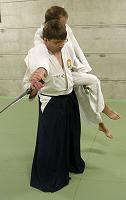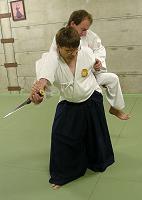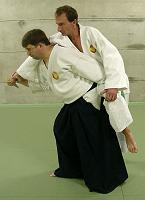Techniques from Achille Marozzo, 1536
The most perplexing aspect of Marozzo's, and indeed most traditional Western dagger techniques, is undoubtedly the bare-handed grabbing of not only your own dagger blade, but also the opponent's. However, our experiments revealed that this is a perfectly viable technique for the kind of dagger involved. There are of course a few important points that should be adhered to:
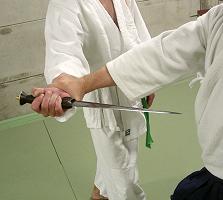
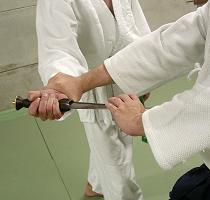
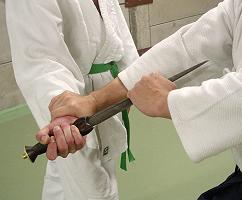
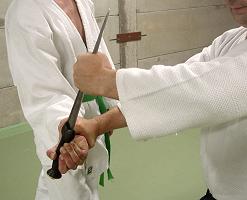
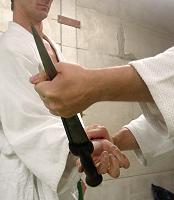
- Firmly grip the enemy's dagger hand. That way he will not be able to make a slicing movement, while you
- Firmly and without hesitation grasp the blade a good distance from his hand, so you can
- Exert leverage against his grip,
- He will be forced to release his grip or risk losing his balance
While a superficial cut is not improbable, people seem to imagine that their fingers will drop to the floor at the slightest touch of a knife's edge. We should keep the context of a life-or-death situation in mind. There is an anecdote in the Chroniques of Jean Molinet, concerning a Picardian noble at the battle of Guinegate, that seems apropos: Jennet of Courteville's horse was killed, and he was trapped under the dead animal. Five French archers came by and were about to cut his throat, when he was able to wrest the knife from his enemy, but he received a cut on the fingers. He was then rescued by John of Wales, who drove off the French, and together they were able to free Jennet from under his horse. He later remarked that the event had been 'like going through purgatory'. Now I can't think of many techniques that would still work while outnumbered five to one and with a dead warhorse sitting on top of me...
Perhaps Vincenzo Saviolo says it best in his advice on grabbing the enemy's swordblade: "...even without a glove, it is better to hazard a little hurt of the hand, and master the enemy's sword, than to give the enemy the advantage by parrying with your sword..."
All defences are against thrusting attacks. While slashing attacks are preferred among the naked savages, the thrust was undoubtedly found superior against clothing and armour (I think I may have been reading too much Richard Burton).
I get frequent messages from readers stating that the techniques only work because the daggers were stabbing weapons and unsharpened. I do not believe this argument for several reasons, but the most important one is common sense: if all it took to defeat these techniques was to sharpen your dagger, everyone would have sharpened their daggers to spite (and smite) their enemies, and everyone trying the non-working techniques would have been killed. In that case we would not find the techniques repeated again and again in manuals spreading several centuries.
Some reconstructed techniques
Note: Jean and Roger are wearing Japanese keiko-gi because they had just finished practicing Aikido when these pictures were taken. While some may find this objectionable, I feel it is a useful reminder that our interpretation of Marozzo is likely colored by our practice of Japanese martial arts, even if unintentional.
Against downward stab, grasp with opposite hand and twist counterclockwise:
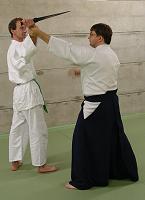
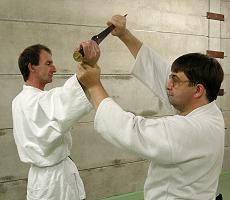
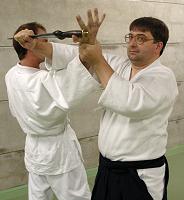
The same, but different grip on the dagger, and twisting counter clockwise:
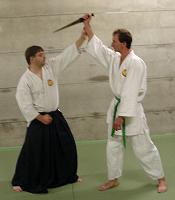
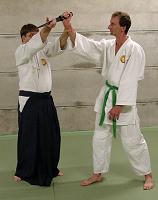
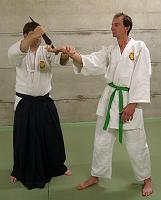
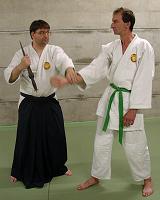
The same, but twist clockwise with additional control on the arm:

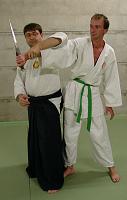
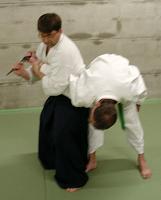
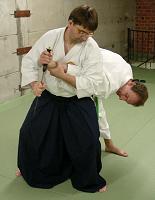
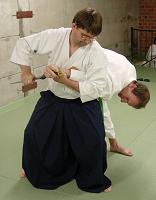
Against downward stab, grasp with same hand, twist counterclockwise:
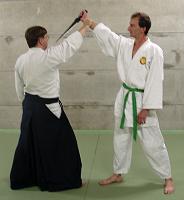
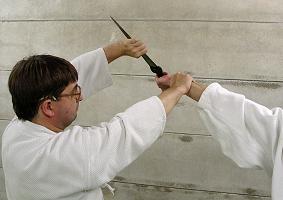
Against downward stab, an elbow lock and ankle throw:
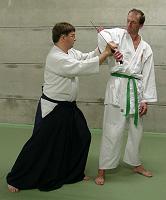
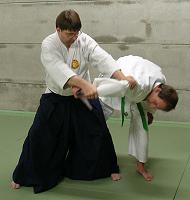
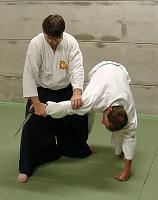
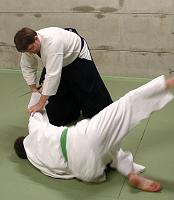
Marozzo also uses this on the unarmed arm, but this would require impeccable timing:
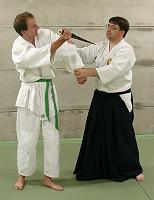
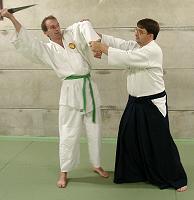
Against throat hold and downward stab, a quite painful blow to the elbow joint:
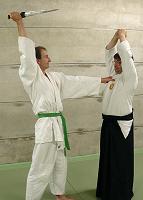
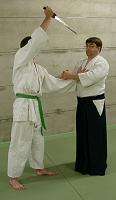
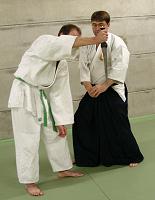
Against throat hold and downward stab, immobilize the right shoulder:
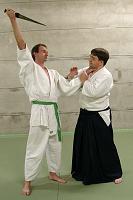
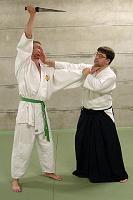
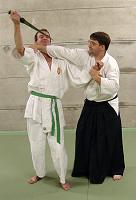
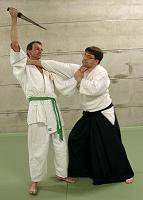
Against upward stab, immobilize the right hand and left shoulder:
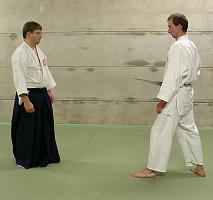
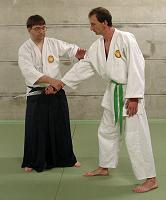
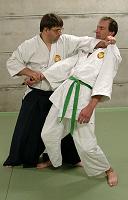
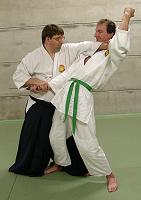
Against downward stab, grasp the right arm with both hands and break it on the shoulder:
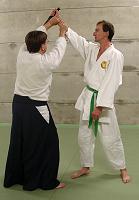
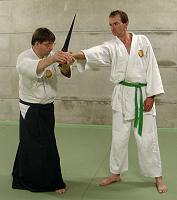
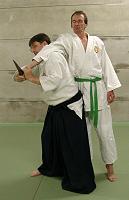
Marozzo shows a dangerous-looking variation where you break the left arm:
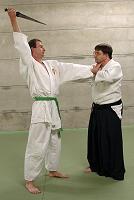
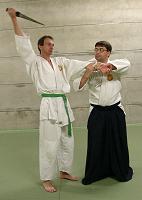
Against downward stab, grasp dagger arm with the left hand and lift the leading leg with the right:
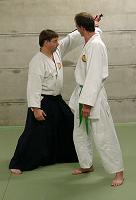
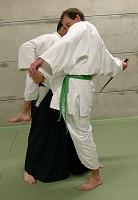
Against upward stab, grasp the dagger hand with the same hand, step behind the enemy and break his neck:
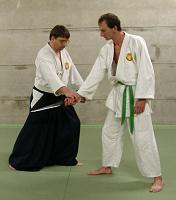
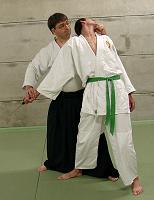
Against downward stab, grasp the dagger hand with the left hand and break the elbow on your stomach:
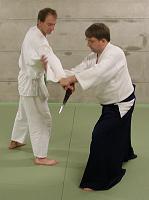
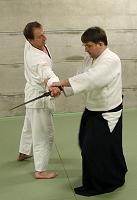
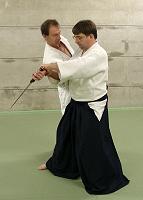
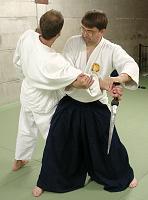
A technique for removing a troublemaker without harm, or dropping him on his head if he should resist:
